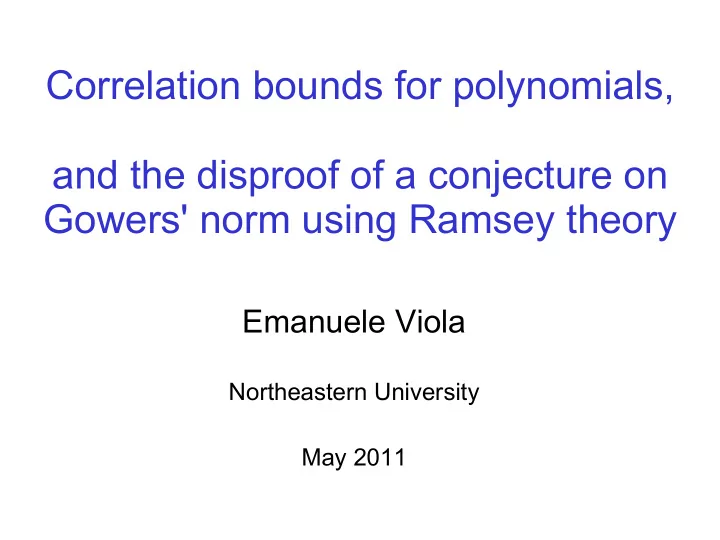

Correlation bounds for polynomials, and the disproof of a conjecture on Gowers' norm using Ramsey theory Emanuele Viola Northeastern University May 2011
Polynomials • Polynomials: degree d, n variables over F 2 = {0,1} E.g., p = x 1 + x 5 + x 7 degree d = 1 p = x 1 ⋅ x 2 + x 3 degree d = 2 • Computational model: p : {0,1} n → {0,1} Sum (+) = XOR, Product ( ⋅ ) = AND x 2 = x over F 2 ⇒ multilinear • Complexity = degree
Importance of model • Coding theory Hadamard, Reed-Muller codes based on polynomials • Circuit lower bounds [Razborov ’87; Smolensky ’87] Lower bound on polynomials ⇒ circuit lower bound • Pseudorandomness [Naor Naor ‘90, Bogdanov V.] Useful for algorithms, PCP, expanders, learning…
Outline • Correlation bounds • Gowers' norm • Disproof of a conjecture using Ramsey theory
Lower bound • Question: Are there explicit functions that cannot be computed by low-degree polynomials? • Answer: x 1 ⋅ x 2 x d requires degree d Majority(x 1 ,…,x n ) := 1 , ∑ x i > n/2 requires degree n/2
Correlation bound • Question: Which functions do not correlate with low-degree polynomials? • Cor(f, degree d) := max degree-d p Bias(f+p) ∈ [0,1] Bias(f+p) := | Pr X [f(X)=p(X)] – Pr X [f(X)≠p(X)] | X distribution on {0,1} n ; often uniform; won't specify E.g. Cor(deg d, deg d) = 1; Cor(random f, deg. d) ~ 0 • More challenging. Surveyed in [V.]
A sample of correlation bounds • Want: Explicit f : Cor( f , degree n Ω(1) ) ≤ exp(-n Ω(1) ) Equivalent to long-standing circuit lower bounds • Candidate f : sum of input bits mod 3 • [Babai Nisan Szegedy ’92] [Bourgain] … [V.] Cor( f , degree d) ≤ exp(-n/2 d ) (good if d ≤ 0.9 log n) • [Razborov ’87] [Smolensky] : Cor( f , degree n Ω(1) ) ≤ 1/ √ n • Barrier: Cor( f , degree log n) ≤ 1/n ?
Exact correlation • Exact bounds: find polynomial maximing correlation [Green '04] • [Kreymer V.] ongoing computer search E.g.: Up to n = 10, Cor(mod 3, degree 2) maximized by symmetric polynomial = sum of elementary symmetric polynomials S 1 := ∑ i x i S 2 := ∑ i < j x i ⋅ x j • Challenge: prove it for every n
Outline • Correlation bounds • Gowers' norm • Disproof of a conjecture using Ramsey theory
Gowers norm [Gowers ’98; Alon Kaufman Krivelevich Litsyn Ron ‘03] • Measure correlation with degree-d polynomials: check if random d-th derivative is biased • Derivative in direction y ∈ {0,1} n : D y f(x) := f(x+y) - f(x) – E.g. D y1 y2 y3 (x 1 x 2 + x 3 ) = y 1 x 2 + x 1 y 2 + y 1 y 2 + y 3 • Norm N d (f) := E Y1…Yd ∈ { 0,1 } n Bias U [D Y1…Yd f(U)] ∈ [0,1] (Bias [Z] := | Pr[ Z = 0 ] - Pr[ Z = 1] | ) N d (f) = 1 ⇔ f has degree d
Using Gowers norm • Lemma [Babai Nisan Szegedy] [Gowers] [Green Tao] Cor( f , degree d) < N d ( f ) 1/2d • Theorem [V.] Cor( mod 3 , degree d) < exp(n/4 d ) Explicit f : Cor( f , degree d) < exp(n/2 d ) – Best-known bounds for d < 0.9 log n. Slight improvement over [Babai Nisan Szegedy] [Bourgain]
Outline • Correlation bounds • Gowers' norm • Disproof of a conjecture using Ramsey theory
A conjecture on Gowers' norm • Conjecture [Green Tao] [Samorodnitsky] '07: For every function f , N d ( f ) = Ω (1) ⇔ Cor( f , degree d) = Ω (1) • [GT] [Lovett Meshulam Samorodnitsky] False for d = 4 Counterexample: f = S 4 := ∑ h< i< j< k x h ⋅ x i ⋅ x j ⋅ x k N 3 (S 4 ) = Ω (1) (not difficult) Cor(S 4 , degree 3) = o(1) (complicated)
Developments • Remark: An inverse conjecture can be saved going to non-classical polynomials [Green Tao] • After announcement of counterexample, [GT] and [V.] noted simple proof of Cor(S 4 , degree 3) = o(1) using [Alon Beigel], in turn based on Ramsey Theory
Simple proof [Alon Beigel] • Theorem Cor(S 4 , degree d=3) = o(1) • Proof for d = 2: Let p be degree-2 polynomial. • Easy if p = Linear + b S 2 b ∈ {0,1} • Reduce to this case: Graph V := {1,2,...,n}, E := { {i,j} : x i ⋅ x j monomial of p } Ramsey: ∃ clique (or indep. set) of size Ω( log n) Fix other variables arbitrarily. ♦
Conclusion • Model: degree-d polynomials over {0,1} • Correlation bounds Barrier: correlation 1/n for degree log n Computer search reveals symmetry [Kreymer V.] • Gowers' norm Gives best known correlation bounds d < 0.9 log n [V.] A false conjecture [Green Tao] [Lovett Meshulam Samorodnitsky] simple proof [GT] [V.] via Ramsey theory [Alon Beigel]
• ∑∏√∩∉∪⊃⊇⊄⊂⊆∈⇓⇒⇑⇐⇔∨∧≥≤∀∃Ωαβεγδ→⇒ • ≠≈ΤΑΘω • ∈ ∉ • • • ∑∏√∩∉∪⊃⊇⊄⊂⊆∈⇓⇒⇑⇐⇔∨∧≥≤∀∃Ωαβεγδ→ • ≠≈ΤΑΘ • • Recall: edit style changes ALL settings. • Click on “line” for just the one you highlight
Recommend
More recommend